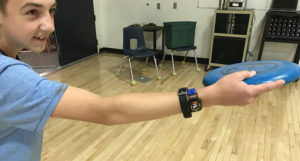Data from the IHT ZONE wrist heart rate monitors his students wear during their PE classes will help Hudson High School (Iowa) teacher Sean Leonard improve his curriculum for the coming school year.
Leonard modified his High-Intensity Interval Training (HIIT)-based program to observe how students’ effort level changed as measured by the ZONE’s heart rate reports generated after each session. With the data in hand, Leonard will spend part of his summer rethinking his approach to next year.
 “We’re just trying to find out exactly which [activities are] best, and a lot of it’s on them,” he said. “We just want to give the students the maximum time possible to get in and stay in their target zone.”
“We’re just trying to find out exactly which [activities are] best, and a lot of it’s on them,” he said. “We just want to give the students the maximum time possible to get in and stay in their target zone.”
The students’ collective heart rate data enabled Leonard to see with more than his two eyes, which can’t always focus on each of the 25 students in each class. The data showed him that:
- Students regularly give their best effort regardless of that day’s activity;
- The majority of students understand how to get into their target heart rate zones and stay there; and
- Students understand that fitness is unique based on each individual’s cardiovascular fitness.
Putting their best feet forward
Following 12 weeks of HIIT-focused classes and six weeks of more varied types of activity, Leonard noticed one consistent result throughout his classes. When the modified activities meshed with what students like to do, results soared.
“If they are doing the things that they enjoy, class is going to be smoother for everybody,” he said. “They know the activities they really like to do, but [they know] that we’re still going to get the fitness benefits out of [them].”
Leonard added some tag-based games as well as some agility activities in with the his tried-and-true fitness elements. He liked how the students responded.
“The last six weeks it brought some variety to the workouts,” he said, “just see the effects of different activities having on heart rate as students were doing some acceleration activities. Even some tagging games and speed and agility and then some other circuit training. We were just collecting a ton of data.”
The data, along with the heart rate monitors, took all of the ambiguity away from both the students and teacher. Neither had to guess whether students were working to achieve that day’s target heart rate.
“I ask that they do their best and they really bought into that,” Leonard said. “On days where motivation wasn’t as high, it was still easy for everyone to see where they were. It’s pretty easy for us as teachers to say, ‘you know, I see where you’re at, you know where you’re at in your zone, so pick it up.’ You can’t really fake it anymore. The data is going to show it all.”
Personalizing PE to Encourage Student Achievement
Analyzing the data collected in his first year using the IHT Spirit System, Leonard will rethink part of his teaching strategy. The data shows him the types of activities students enjoy, so he’ll work to incorporate more of those activities into his lesson planning.
“The monitor puts ownership on the student,” he said. “I’m looking forward to continue to make changes that best benefit the students.”
The changes may include giving students more choice to exercise as they see fit.
“I’m beginning to wonder: does it matter what we do as long as they’re in the zone as long as we want them to be and they know how to get there and stay there?” Leonard said. “I think you have to be open and willing to change your curriculum and how you do things based on what you’ve learned.”
As long as the data continues to show students improving their fitness by achieving their daily goals, Leonard will let them take the lead.
“It doesn’t have to be the teachers saying ‘here’s what we’re doing,’” he said. “We can give kids some freedom and some choice. As long as we’re getting what we want out of them as far as fitness benefits, I don’t think that [who decides the activities] should matter.”
Seeking IHT Spirit System information?

